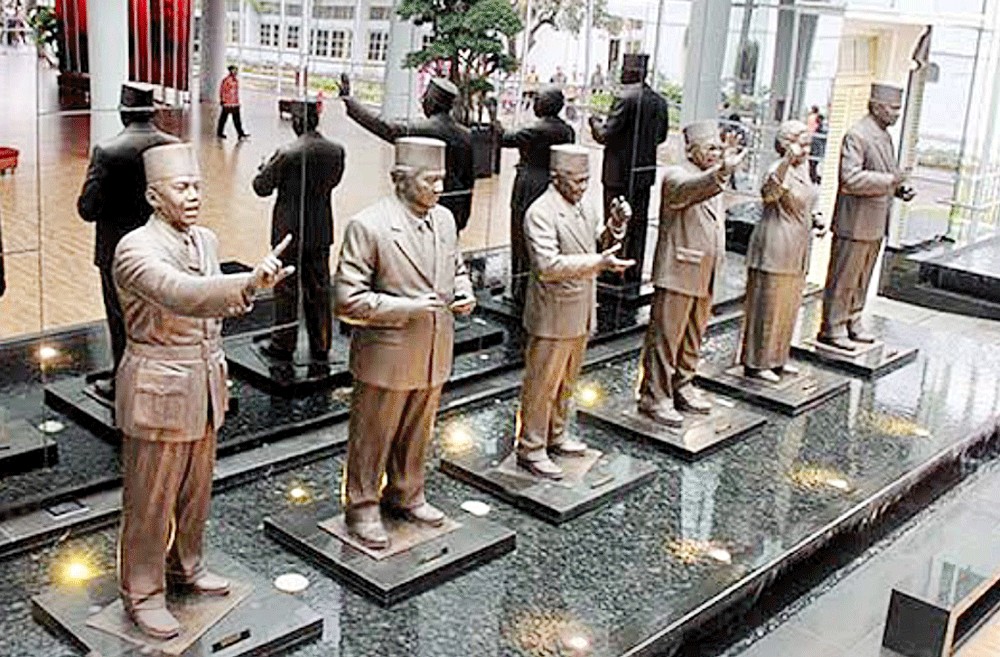Museums of presidents: Displays of ostensible grandeur
Change Size
 President statues by Yusman. (-/Agus Dermawan T.)
President statues by Yusman. (-/Agus Dermawan T.)
T
em>There have been six presidents in Indonesia’s 73-year journey as an independent nation, and museums located in Bogor, West Java, and in Yogyakarta are great starting points to learn about them.
The one in Bogor is the Balai Kirti Museum, and it is part of the Bogor Palace compound.
Balai Kirti, a three-story glass building, occupies an area of 3,212 square meters. It is situated on the left side of the spacious and grand palace.
The Sanskrit word kirti means a room of glory for heroes.
Therefore, Balai Kirti is a memorial house in honor of the great services rendered by special heroes, in this case six former Indonesian presidents — Sukarno, Soeharto, BJ Habibie, Abdurahman “Gus Dur” Wahid, Megawati Sukarnoputri and Susilo Bambang Yudhoyono.
Apart from the six presidents’ biographies, which take up most room in the museum, Balai Kirti also depicts the history of Indonesia’s struggle for independence.
The ground floor illustrates the nation’s journey, from the Youth Pledge of 1928 to the birth of the Pancasila state philosophy and the Preamble of the 1945 Constitution.
The same floor also displays a digital map of the Unitary State of the Republic of Indonesia (NKRI), the official name of Indonesia as a sovereign country. All the exhibits are accentuated by bronze statues of the six presidents with gestures of grandeur created by artist Yusman.
The second floor of Balai Kirti presents various presidential memorabilia, such as official suits worn to attend ceremonies and welcome state guests, hats, order of merits, medals of honors, historic photos, caps, shawls and books written by the presidents.
On this floor visitors also find replicas of presidential offices, complete with the chairs they sat on as they determined state policies.
The walls on the second floor feature videos and interactive digital albums inviting visitors to surf the audio-visual world. Visitors can also read some of the presidents’ most famous quotes, such as Sukarno’s “Never ever forget history.”
The second floor also features a large painting by Jeihan Sukmantoro, outlining the shadows of the six presidents in black and white.
Jeihan, known for putting pitch-black eyes on the human characters in his paintings, said the painting was worth Rp 60 billion (US$4 million) and was contributed to the state.
Not far from Jeihan’s painting is a presidential podium for delivering speeches with the Presidential Palace as its backdrop. Here, any visitor can pretend to be a president and deliver speeches.
Around 560 kilometers from Bogor is Yogyakarta, the location of the Museum of Indonesian Presidents.
This museum, part of the Gedung Agung compound, displays historic photos arranged in esthetic infographics as well as six large biographic paintings of the presidents, the works of realist artists Dede Eri Supria, Melodia, Ivan Hariyanto, Robby Lulianto, Gunawan Hanjaya and Lim Hui Yung.
These paintings are the museum’s main attractions, because the painters used the 3-meter wide canvases to illustrate the peaks of accomplishment of each president while in office.
Based on a consensus formulated by several cultural observers, the painters themselves and the ministry/State Secretariat, the statesmen are held in high esteem.
First President Sukarno is described as “Courageous President and Great Hoister of the National Flag”, bearing the symbol of Adipati Karna, a warlord in the Mahabharata epic.
Sukarno’s successor, Soeharto, who ruled Indonesia for 32 years under his dictatorial New Order regime, is named “President of National Economic and Social Development” and symbolized by King Ramawijaya of the Ramayana epic.
Habibie, who took over the presidency after massive political and economic turmoil forced Soeharto to step down in 1998, is given the title of “President of Technology and Democracy”, seen as the personification of genius figures in the legendary Buginese book La Galigo.
Gus Dur, who was the successor of Habibie and whose presidency was cut short due to a politically motivated impeachment, is identified as “President of Pluralism”, with King Yudhistira of Mahabharata as his symbol.
Megawati, the daughter of Sukarno, who took advantage of the impeachment of Gus Dur, is designated as “Guardian of History and Reform”, personifying Tribhuwana Tunggadewi, the sovereign queen of the great Majapahit Kingdom from 1328 to 1351, while Susilo Bambang Yudhoyono, Indonesia’s first democratically elected president, is introduced as the “President of Diplomacy and Post-Disaster Reconstruction”, earning him the symbol of Vishnu, the god of three realms, or Tri Loka.
“These museums remind the public of the fact that paintings are the most essential means of documentation of the national struggle, superior to photography. From the 1940s to 1960s, Sudjojono and peers did it well,” said Edi Sunaryo, a postgraduate lecturer at Yogyakarta’s Indonesian Arts Institute.
“But in the following period until the 1990s, there was no more such painting portrayal. Only in the 2000s was it revived through the two palaces. That is remarkable.”
Perhaps, the most disturbing aspect of the museum’s exposition is that the Indonesian presidents are given the full image of grandeur, invulnerability, flawlessness and benevolent leadership.
This way, some of their dark deeds remain concealed, although such historical obscurities have become open secrets.
For example, Soeharto indirectly killed at least 3 million people during the communist purge from 1965 to 1968 to become the president, but such horrific atrocities are conveniently overlooked at the museums.
Museums can be likened to book covers, and since they say you shouldn’t “judge a book by its cover”, society will scrutinize the museums for their content.









